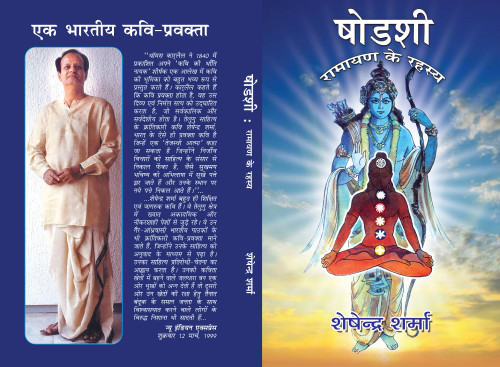Ramayana, a replica of Vedas
S. VARADARAJAN
There are several versions of the Sri Ramayana, one of the two greatest epics. Following Sri Valmiki Ramayana several editions have been published in various languages, besides scores of commentaries written across centuries. Late. Gunturu Seshendra Sharma, scholar poet of 20th Century unearthed secrets of the Ramayana through his popular Telugu book “Shodasi”.
The novelty of nomenclature Shodasi , called Sri Vidya is reflected , in the 16th Chapter . Sharma’s intellectual depth comes forth in analyzing Sundara Kanda specially through Kundalini Yoga . The author highlights hidden truth in Valmiki’s thought that is similar to Vedas and says that Trijata’s dream in Sundara Kanda reflects Gayatri Mantra of 32 Syllabi in 4 lines. Sharma pays rich encomiums in the description of Lanka surrounded by three impregnable borders. He compares these three borders with Trikuta viz... Shakti , Kaamaraaja , Vagbhava Kutas with those of Sri Vidya in Kundalini . A staunch believer of Vedas, the author feels that Ramayana is a replica of Vedas and oriented towards the character of Indra . He concludes that in Ramayana the mentioning of the supreme God is Indra and not Vishnu, as the presiding deity of valour in Vedas. Utterances of the word Vishnu were considered to be imaginary overstatements in the author’s view.
This book lends a new perspective to the Ramayana by adding the dimension of Kundalini Yoga .
The foreword by Vishwanatha Satyanarayana adds credibility to the book. The current work is an English translation of the original by Gurujada Suryanarayana Murthy , a scientist by profession . His proficiency in the subject is evident in the translation throughout that doesn’t swerve from the original’s purport.
The Hindu
(Friday Review: 2nd October 2015)
Indian Express : Review
Ramayan Through Kundalini Yoga
Shodasi is an ideal read for Sanskrit-literate readers who are open to eclectic yogarthas and connotative meanings
Published: 28th November 2015 10:00 PM | Last Updated: 28th November 2015 09:53 AM | A+A A-
By Mani Rao
So you thought Vyasa was before Valmiki, Mahabharat was before Ramayan, Rama a Vishnu avatar, and tantrism distinct from vedism? Think again. In Shodasi: Secrets of the Ramayana, Telugu poet Seshendra Sharma re-reads the Ramayan to come up with a number of new conclusions.
Much of the book sets out to prove that Ramayan was written before the Mahabharat. Sharma discusses how Indra is cited more often than Vishnu, thus placing the context of the Ramayan closer to Vedic than Puranic thought. He quotes from the Mahabharat to show how it follows descriptions of hills, rivers from the Ramayan. The Mahabharat has some prose, and therefore, it must have been composed after Ramayan, which is entirely in poetry. These are only some of the numerous reasons that Sharma offers to suggest a new sequence of our itihasas.
Sharma’s book is also an experimental reading of the Ramayan through the interpretive lens of what he calls Kundalini yoga. Hanuman’s flight to Sri Lanka gets a new interpretation. “Charana Charite Patti” is interpreted as the path of Kundalini, and the first verse of the Sundara Kanda “Tatho Ravana Nithayah” is interpreted by Sharma to refer to Hanuman traversing the sushumna nadi of the Kundalini.
Trijata’s dream becomes the Gayatri mantra through an imaginative recasting of words as numbers. Gaja (elephant) means eight, danta (teeth) means thirty-two, and maha-gaja-chaturdantam somehow also adds up to 32 syllables, which is the number of syllables in the Gayatri mantra. That Trijata’s dream is halfway through the Ramayan also becomes significant for Sharma, he calls it the ‘central bead’ in the Ramayan garland of 24,000 beads. Identifying 32-syllables as the Gayatri follows a convention, for mantras are referenced by the number of syllables; however, it is the “secret” yogartha—or mystical, anagogical translations—derived by Sharma that becomes problematic, unless he is considered an authority in his own right.
Shodasi.JPGSharma goes through an elaborate argument to conclude that the name Sundarakand is unrelated to any descriptions of beauty of any of the main characters in the Ramayan. However, Soundarya and Tripura-Sundari are well-known conventions in the tantric tradition and hence, Sharma concludes that Sundarakand derives its name from Shakti’s beauty, and “Sundara-Hanuman” means “Hanuman who is a devotee of Devi” (117).
A coda in this book is about the benedictory verse in Kalidasa’s Sakuntalam which has traditionally been understood to refer to Ishwara. Sharma re-interprets this verse highlighting the “eight forms” of the last line as the eight forms of Devi that please Ishwara.
This book is suitable for a reader who is Sanskrit-literate and open to eclectic yogarthas and connotative meanings. Sharma cites substantially from the Ramayan in roman but without diacritics, this is difficult to follow; and he does not always include translation. Sharma often cites commentators without citing names and sources. It is not clear why the book is called Shodasi—readers may note, this book is not about the Srividya tradition. Even if the reader is unconvinced by Sharma’s reasoning or methodology, the free flow of references may prove absorbing for a reader interested in the subject.
This could also be an eclectic reference for a scholar researching tantric elements in the Ramayan.
---------------------------------------------
A Resplendent Icon of all Arts
This is an exemplary book which elevated the status of Indian Literary Criticism to the peaks of the world literature. Shodasi is a name associated with a great hymn. The title suggests that it’s a book on spiritual discourse. A reading of this book suggests that the spirit of scientific temper is critical to comprehend Valmiki’s Srimad Ramayana. Besides this, command on Vedic or Scriptural knowledge is essential. What does a layman has to say when a towering personality like Viswanatha Satyanarayana himself extolled the critical acumen and serious scholarship of Seshendra Sharma.
Sharma has made it crystal clear that unless one has an apparent understanding of the plot’s context, psyche of the characters, and the milieu of the bygone days supplemented by extraordinary scholarship, sound knowledge of phonetics and awareness on contemporary issues; one cannot easily comprehend the poetic diction of Valmiki. The debate on the phrase “Netraturaha” is a fitting example. The uniqueness of the title, Sundara kanda, Kundalini Yoga, Gayatri Mantra secretly hidden in Trijata’s dream sequence, considering The Bharatha as an image of The Ramayana.... this book is a repository of many such critical discourses. It is replete with inconceivable and unfathomable issues. This magnum opus is an invaluable gift to the Telugu literature.
- VIPULA, Viswa Katha Vedika: May 2014
(An exclusive Telugu Monthly Magazine for stories)
* * *
Valmiki Ramayana – Greatest Medicine for Mankind
The story of Ramayana is prescribed as textbook for students. Sita and Rama are worshiped as prime couple. No need to mention about reciting it. Whether Valmiki was satisfied with simple narration of the story? Seshendra Sharma denies it.
He analyzed it mentioning that to understand the inner meanings of Valmiki Ramayana, the scientific knowledge is essential. The underlying secret of the sage’s mind will be known through the knowledge of science. It is the firm opinion of Seshendra that the argument that “the sciences are for scholars only” is a conspiracy hatched by Selfish scholars and lazy uneducated persons.
Seshendra who has democratic ideology and conviction on science and literature informs the public about the secrets of Ramayana expounded by Valmiki. He explains that Valmiki dedicated ambrosia (The Greatest Medicine) named “Kundalini Yoga” to the mankind. The poetry in the metre of Anushtup Sloka is the honey coating to the medicine. It was explained with great introspection and exemplary scholarship. He concludes that the Ramayana is older than the Maha Bharatha and it is another form of Veda. Valmiki introduced the system of meditation in Ramayana. The Introspection and research bent of mind of Seshendra are spread over in the book in two streams. The exuberant fragrance of scholarship is experienced throughout the book.
The present generation can understand the scholarship of Seshendra in Vedas and Mantra Sastra. Seshendra is a poet who has composed unique Ruthu Ghosha (Cry of the Seasons: Metrical Poetry) and revolutionary free verse –Mande Suryudu (The Burning Sun).
- Andhra Prabha (Telugu Daily), 24th August 2014.
* * *
Two Great Peaks in the world literary criticism and research
Shodasi: Secrets of The Ramayana and Swarnahamsa Harshanaishada from the mighty pen of the great Telugu poet, Gunturu Seshendra Sharma are considered to be the two great peaks in the world literary criticism and research. This is a truth most contemporary Telugu writers and readers aren’t aware of. The way Seshendra could discover Kundalini Yoga, Gayathri Mantra in Shodasi, he could discern the treasure trove of mantra yoga, Sri Mahatripurasundari, Chintamani mantra in Swarnahamsa.
At a time when our universities which are mere Degrees production Units, churn out “solid waste” in the name of research; Seshendra even while attending to his job as a Municipal Commissioner created research oriented critical volumes like a sage.
Though Shodasi was published in 1967 and Swarnahamsa in 1968; Swarnahamsa was created by him much before Shodasi was conceived. The concepts that Srinatha, Nannayya and Mallanatha, the Telugu Classical poets couldn’t decipher,
Seshendra could. He humbly submits that he is most fortunate that the triumvirate had left behind some pertinent concepts only to be discovered by him at a later stage.
These two great kavyas were serialised under the editorship of late Neelamraju Venkata Seshaiah in Andhra Prabha Daily, Sunday Literary Supplements from 1963 to 1967 and Seshendra’s poems and non-fiction were published in the book forms (6) only after they appeared in serial form in Andhra Prabha.







